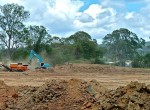News
2016-09-05 | permalink
New study reveals humans’ growing ecological footprint
 Human pressures on the planet are increasing (Photo: CC0)
Human pressures on the planet are increasing (Photo: CC0)
Although human pressure on natural habitats is growing at an alarming rate, threatening especially the world’s species-rich biodiversity hot spots, the ecological footprint is not increasing as fast as the world population. This is one findings of a team of researchers from the University of Northern British Columbia, the University of Queensland and the Wildlife Conservation Society (WCS). The study, published in the journal Nature Communications on August 23, is an update to an earlier human footprint map released in 2002. Using data from satellites and on-ground surveys, the scientists analysed the impacts of human activities on the environment between the years 1993 and 2009. They looked at different human pressures, including data on the extent of built surfaces, roads and railways, navigable waterways, crop and pasture land, human population density and night-time lights. The team found that while the global population grew 23% and the world economy grew 153% over this 16-year-period, the global human footprint increased only by 9%. Dr. Oscar Venter of the University of Northern British Columbia who led the study said this is encouraging since “it means we are becoming more efficient in how we use natural resources.” However, human pressures have had severe and extensive environmental impacts. “Our maps show that three quarters of the planet is now significantly altered and 97 percent of the most species-rich places on Earth have been seriously altered. There is little wonder there is a biodiversity crisis,” said Dr. James Watson, co-author of the study from the University of Queensland and WCS. Regions that are very rich in biodiversity and host large numbers of threatened species, so-called biodiversity hotspots, are affected most. Only a few places with many threatened species remained impact-free, including central Borneo and the Central Asia Deserts. Overall, in around 71% of the world’s different ecological regions human pressures have increased by over 20% since 1993. Forests tend to suffer most from environmental pressures, for example the temperate broadleaf forests of Western Europe, the eastern United States and China; the tropical dry forests of India and parts of Brazil as well as the tropical moist forests of south-east Asia. The researchers said one of the main drivers of deforestation and biodiversity loss is the expansion of agriculture. “The suitability of lands for agriculture appears to be a major determinant of the intensity, extent and temporal trends of pressures across the globe,” they write. Agriculture has expanded into more marginal lands. While the most suitable areas showed little change since 1993, areas moderately suitable for farming have seen a rapid increase in human use since then. The authors highlight that maintaining biodiversity will require extensive restoration to remove and mitigate existing pressures, especially in the world’s most biologically valuable regions. Efforts may be particularly successful where pressures have arisen only recently, as the time-lags before biodiversity declines could mean that many species could still be saved, they added. (ab)

